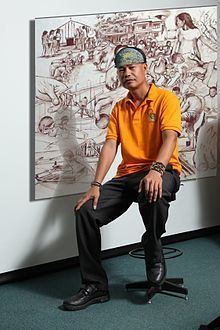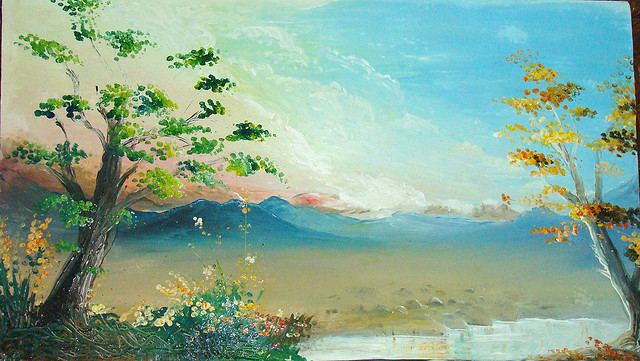Nationality Filipino Name Elito Circa | Role Artist | |
 | ||
Full Name Elito Villaflor Circa Education No formal education in painting Known for Hair and Blood Folk Painter Notable work Blood painting of Manny Pacquio Hearted fist, Pantabangan History Mural, A Thousand and One Lives Mural Awards Folk Artist of Pantabangan Patron(s) World Vision Zodiac Sign Aquarius Similar Geraldine Javier, Danilo Palomer Santiago, Rodel Tapaya | ||
Artwork of internationally reknown Artist "Amang Pintor": Elito Circa | Iba Ang Pinoy
Elito Villaflor Circa (born January 28, 1970), better known as "Amangpintor", is a Filipino painter and internationally known folk artist, who paints using indigenous human hair and blood fluids with mythologism and mythicalism subject matters. He was the "First Hair and Blood Painter" of his generation and his signature subject is Legend of Minggan. A father of Indigenouism Art, upholding and advocating Contemporary Indigenous Philippine Art and also popularized Hand Painting performances done within 5 to 10 minutes in a canvas of 432 square inches using the three primary colors.
Contents
- Artwork of internationally reknown Artist Amang Pintor Elito Circa Iba Ang Pinoy
- GMA 7 Ripleys Believe It or Not Hair and Blood Painter Amangintor
- Early life and education
- Career
- As an artist
- Medium and Philosophy
- Art of Healing
- Writing
- Music
- Film
- Art Educator
- Influence
- Indigenouism
- Paintings and Drawings
- Awards and Citations
- Art Exhibitions and Hand Painting Show
- Published Collections of Works
- References
GMA 7 Ripley's Believe It or Not (Hair and Blood Painter-Amangintor)
Early life and education

Amangpintor was born to Juan Llagas Circa and Josefina Salazar Villaflor in the old town of Pantabangan, Nueva Ecija, Philippines on January 28, 1970. He was the youngest of seven children. His education was funded through a scholarship from World Vision Foundation under foster parents Cynthia and Leigh Brown from Perth, Australia who supported his studies through secondary school (awarded Artist of the Year) until he graduated at the Central Luzon State University with a degree in Elementary Education.

Amangpintor has no formal training in painting. He started drawing, using charcoals from the stove in their kitchen, on the walls of their house in Pantabangan town when he was eight years old. He completed an estimated 600 works of arts since 1980, which he gave to some of his teachers, friends and neighbors during that time. He also painted a series of 15 paintings for the "Legend of Minggan" which depicted the courtship of the giant "Minggan" to "Mariang Sinukuan" who was supposed to be dwelling in Mount Arayat. Amangpintor also made a series of paintings about the place of his birth, depicted about the evacuation of the residents of Pantabangan when their town was about to be submerged by Pantabangan Dam.
Career
In 1978 Amangpintor received his first award, winning a Children’s Art Competition sponsored by DZRH radio station using Zimatar ? and Tigani, popular fantasy folk heroes being aired on air as an adventure series, as a subject.
Amangpintor joined CLSU-Artist Club while studying and in 1992 he was recognized by the Central Luzon State University through the College of Arts and Sciences as their first Student Artist. He was given a special Cultural Award upon his graduation in 1993.
He co-founded the Samahang Makasining (Artist Club), Inc. and served as Board Chairman in National Level for seven years. He is also a tourism Adviser of Pantabangan local Government Unit and the Visual Arts Chairman of Association of Nueva Ecija Artist group project of Provincial Governor's Office. He recently founded Makasining Pinas (a subsidiary group of the Samakang Makasining (Artist Club), Inc) in the different Municipalities and Provinces in the Philippines.
In 2001, during his reign as a chairman of the Board of Trustees of the Samahang Makasining(Artist Club), Inc., he compiled and popularized all probably never-heard-before traditional games or as he calls it Indigenous Games (Laro ng Lahi in Filipino).
In 2007 Amangpintor was recognized by his home town as Pantabangan Folk Painter. And in 2008, he started actual hand/finger painting performances with music or band accompaniment, which he termed PintaOke or PintAwit.
Amangpintor was recognized by the National Commission for Culture and the Arts (NCCA) as first Filipino hair and blood painter in 2009 and was featured on NBN TV4 national TV channel with episode called Sining Gising.
Amangpintor received the Art and Culture "Gintong Butil" award from CLSU Alumni Association, Inc. in 2010 during the celebration of annual alumni homecoming.
As an artist
Amangpintor's artistic inclination was encouraged by his father, a carpenter who brought him his first painting materials. Most of his paintings have a story behind or are based on his philosophical articles written before the paintings. }}
Medium and Philosophy
In 1978, Amangpintor started to use his own hair to make his paintbrushes with the help of his father, a carpenter during that time and started bringing home small pieces of plywood and some paints. He is a unique Filipino folk artist who uses his own hair for his paintbrushes. At the age of 15, Amangpintor continue to paint with large canvases using indigenous materials and natural raw materials such as soy sauce, charcoal from fireplace, smoke from candle, extract from tomato, onion, black palm, Banana and from fruits.
In 1982, as the beginning, Amangpintor also started signing his drawing using his own blood to authenticate the artworks and later explore and experiment it as a medium in paintings especially for flowers and related heart love feeling subjects. He calls it "Blood is life and love, love with sacrifice".
In 1992 Amangpintor continue to paint "Lukso ng Dugo" (Filipino term) he uses his blood as medium for some of his painting and incorporates his hair in capturing on the canvass images of human persons or nature’s view, one who possesses the characteristics of truth in himself and he who refrains from colonialism in thoughts and materials. Combined with the philosophy of the painter who molded his thoughts and well-being, he is able to build self-confidence and self-esteem since his childhood.
First Filipino artist uses own blood as paint and hairs as brushes and mix it with paint to have an effect on canvas. He believed in reincarnation, which he will be reborn and recognize his paintings. But even if blood is not used in painting his subject, he always signs his name in his work of art with his own blood. The significance of his works connects arts and sciences principles through DNA (the Hair and Blood) as authenticity and also his unique spiritual beliefs especially in God.
"Lukso ng Dugo"—when a loved one left a family and have not seen each other for a long time, and an unexplainable feeling of happiness when they see each other again. This is a basis that the blood connects the family and the mutual feelings in this situation.
The folk painter believes that painting his blood on canvass creates pieces that symbolize life, love, and sacrifice. Most of his masterpieces also depict rural life in his town in Nueva Ecija.
His works were featured by TV stations in the Philippines and earlier at Ripley's Believe It or Not.
In 2015 "Fight of the Century", Amangpintor also created Manny Pacquiao's large painting using his own blood. This painting of Pacquiao title "Manny Pacquiao Hearted Fist" depicts the different aspects of the boxer's life, including his stint as a singer, face charisma and his role as a congressman. He also emphasized Pacquiao's religiosity in this painting.
In 2016, A montage of Philippine President Rodrigo Duterte's familiar poses along with the official seal of the president and other symbolic materials were created using Amangpintor's blood as he believes that using his blood to create works of art signifies life. His "Duterte in the Center of the Triangle" painting have become viral online after posted it on the internet.
Art of Healing
Amangpintor conducts hand painting performance of nature views. Using four colors (Red, Yellow, Blue and white) on a 24 X 26 inches canvas, he will be finished the painting within 5 to 10 minutes. He has been invited to perform in different events and occasions like provincial, town, school, university and agency foundations and in wedding and birthday.
In 2015, Amangpintor started a new indigenous painting titled A Thousand and One Lives as a gesture of dedicating of life in this noble profession of educating the youth. The 1001 teachers and DepEd employees was participated and literally donated parts of their body, their hair and blood incorporated in the mural.
Writing
In his childhood Amangpintor created and personalized 5.5 X 4.25 inches comics normally 8 to 12 pages that he shared with his friends. In early 80s, he wrote the Legend of Minggan, or "Sulat babala ng panahon sa bayan" in Filipino. He related the story of Minggan to the actual history relocation of submerged old town in 1973. Based on his article, giant Minggan returned in 1973 to finish his promises of love to Mariang Sinukuan, a goddess of nature who lives in Mount Arayat Pampanga. His articles was adopted by the Mayor of Pantabangan in 2007 to promote Pantabangan as a tourist destination.
Music
Amangpintor produces music based on his spiritual beliefs, nature attachment and community based development advocay. These include (Filipino Term): Hinihilom ng Pasko, Pag-ibig ni Minggan and Langkay na Signal.
Film
Amangpintor was video editor of the indie film ″Tik-Tak-Bo" and ″Makukulnay″,
Art Educator
Amangpintor uses comics, stories, poems, musics and articles for teaching arts to rural children. He also introduced indigenous materials for painting including making of brush out of strands of their hair.
Influence
Amangpintor influenced many other Filipino painters for using indigenous materials or natural raw materials as paint such as extract from onion, tomato, tuba, coffee, rust, molasses and other materials available anywhere. Human blood as medium has also influenced the American artist Vincent Castiglia .The finger and hand painting performance also influenced other young visual artists especially students. The Filipino identity can be preserved through the use of indigenous materials and native way of arts.
Indigenouism
Amangpintor's paintings of 1978–1993 reflected his interest in indigenous materials. He conducted intense studies on the effects of strands of hair as texture, human blood preservation and the technical means that painters used to represent these effects. Amangpintor's group of artists movement want to protect the environment against global warming by continuously supporting the advocacy of using indigenous materials for painting and introduce it to other pupils/ students to address the issue of lack of materials for painting due to financial problem.
The concept of Indigenouism, initiated by Elito Circa in 1993, marks a movement towards utilizing indigenous materials in paintings and promoting this practice among other artists. This movement has encouraged numerous artists within both the town and province in the Philippines to incorporate significant and fundamental agricultural products as mediums in their artwork. Additionally, the Indigenouism movement has advocated for towns to adopt local products as part of their distinct identities.
His most significant contributions to the history of art were in collaboration with Indigenouism in 2007, and the role he played in the development of Indigenouism. Therefore, the term was derived from Indigenous Materials which are naturally and locally found in a specific place or area used by the native or indigenous people.
Paintings and Drawings
Amangpintor is always depicting the life of Pantabangan from the 70s (time where the town of Pantabangan was submerged by the water) to the present with the style of creating image of Minggan on every painting that he made. Pantabangan has sacrificed its land as it was drowned and made into a dam for the benefit of other towns by providing ample water supply for their crops.
Awards and Citations
* Selected only
Art Exhibitions and Hand Painting Show
* Selected only
Published Collections of Works
for more information see references
